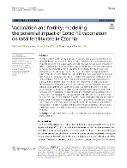Vaccination and fertility: modelling the potential impact of Covid-19 vaccination on total fertility rate in Czechia

Datum vydání
2024Publikováno v
GenusRočník / Číslo vydání
80 (1)ISBN / ISSN
ISSN: 0016-6987ISBN / ISSN
eISSN: 2035-5556Metadata
Zobrazit celý záznamKolekce
Tato publikace má vydavatelskou verzi s DOI 10.1186/s41118-024-00236-x
Abstrakt
As with Northern European countries, Czechia experienced unexpected fertility developments during the Covid-19 pandemic. Fertility in Czechia increased between 2020 and 2021 from 1.76 children per woman to 1.83. However, between 2021 and 2022, fertility fell significantly to just 1.62 children per woman. The main change that occurred between 2020 and 2021, which is thought to have affected fertility one year later, comprised vaccination against Covid-19. This vaccination of the adult population was very specific in terms of both its scope and the timing of vaccination for each age group as organised by the state. The mass scale of the vaccination campaign and its implementation within a very short period of time were unprecedented. However, along with the significant degree of uncertainty concerning the appropriateness of vaccination for pregnant women, vaccination was seen as a factor that potentially acted to significantly change women's reproductive plans in the short term and, as a consequence, potentially exerted a significant short-term impact on both birth rates and fertility indicators. This study models the maximum potential impact of vaccination on fertility levels under the assumption that all the vaccinated women chose to avoid conception in the month in which they were vaccinated. Applying the indirect standardisation principle, we calculated the expected monthly live births after excluding women who were vaccinated nine months earlier. The comparison of hypothetical and observed fertility revealed that the perceived potential impact of vaccination was largely consistent with the observed fertility decline in Czechia between 2021 and 2022.
Klíčová slova
fertility, vaccination, Covid-19, conception, delay of conception, indirect standardisation
Trvalý odkaz
https://hdl.handle.net/20.500.14178/2791Licence
Licence pro užití plného textu výsledku: Creative Commons Uveďte původ 4.0 International






